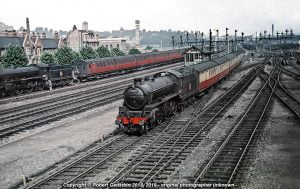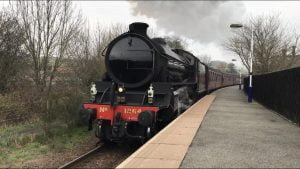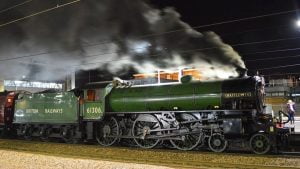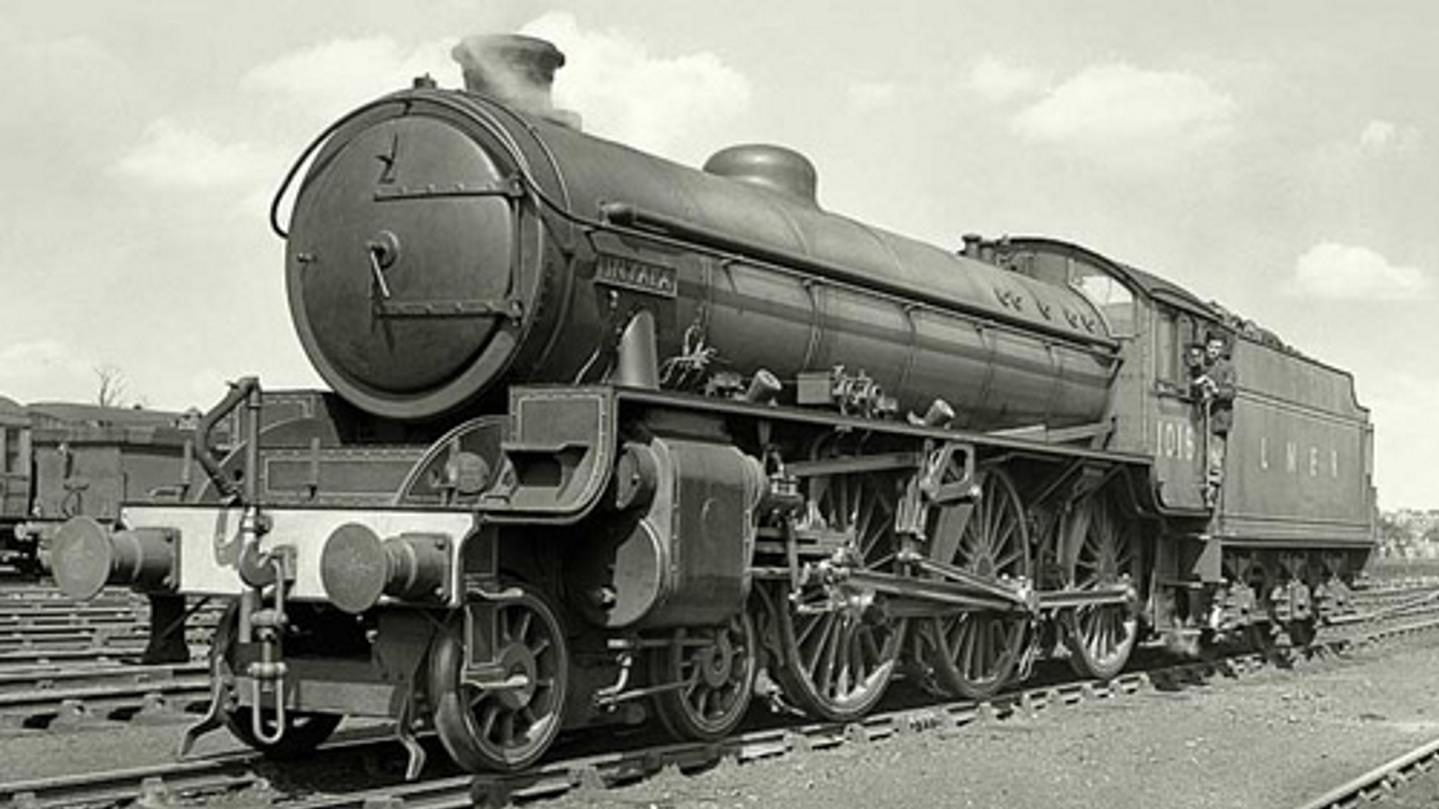Built for mixed traffic duties during the strict conditions of World War 2, the B1s were Thompson’s take on a 4-6-0 2-cylinder general purpose engine. Once exploring the working lives of these practical locomotives, we will see how the preserved examples have been kept.
LNER Thompson B1 Class
The B1s or “Antelope” class formed part of Edward Thompson’s locomotive policy for the London and North Eastern Railway when he succeeded Sir Nigel Gresley as Chief Mechanical Engineer (CME) in 1942.
Thompson’s policy saw many radical changes to the current policy set out by Gresley, such as rebuilding many engines and creating new ones, such as the B1s.
Design and Construction
The ‘Big Four’ railways played a huge part in assisting the war effort. Not only did they transport thousands of troops and tonnes of supplies, but the heavy engineering facilities used to produce steam engines based across the country were also utilised for building ammunition and vehicles.
During the conflict, the government controlled the railways and restricted what type of engines could be built, plus there was reduced maintenance due to a smaller workforce, which lead to simple and cheap designs being granted for production.
On starting his post of CME, Thompson planned big changes for the LNER. He disliked many of Gresley’s designs, with the Gresley Conjugated valve gear being on the top of his list. Lack of through maintenance lead to issues with some Gresley engines, with Thompson drawing up plans for a new mixed traffic engine.

For reliable running with quick and easy maintenance, the B1s featured Walschaerts valve gearing on two outside cylinders. Using the 4-6-0 wheel arrangement gave good traction, and the boiler was a modified Diagram 100A type, the changes being higher pressure and larger grate. Where possible, existing components were incorporated into the design to save cost and time.
The basic dimensions for the class as built include: 4-6-0 wheel arrangement (coupled wheels – 6 foot (ft) 2 inch (in), leading wheels – 3ft 2in), Diagram 100A type boiler pressed at 225 lbf/in2, two outside cylinders (20 in diameter and 26 in stroke), total weight came in at 71 long tons (engine only) and tractive effort of 26,878 lbf.
Production Series
Production was spread across four sites, two in house on the LNER, Darlington and Gorton Works, and two contractors, the North British Locomotive Company and Vulcan Foundry. All 410 locomotives were built across nine batches between 1942 and 1952.
- Ordered Aug 1942 – No.8301 (Dec 1942) to 8310 (June 1944) – 10 engines – Darlington Works
- Ordered May 1944 – No.1010 (Nov 1946) to 1039 (Dec 1947) – 40 engines – Darlington Works
- Ordered Aug 1945 – No.1040 (Apr 1946) to 1137 (Mar 1947) – 100 engines – North British Locomotive Company (Order No.L958)
- Ordered Jan 1946 – No.1140 (Apr 1947) to 1189 (Aug 1947) – 50 engines – Vulcan Foundry (Order No.2333)
- Ordered Jan 1946 – No.1190 (May 1947) to 61339 (Sep 1949) – 150 engines – North British Locomotive Company (Order No.L963)
- Ordered Nov 1947 – No.61350 (July 1949) to 61359 (Oct 1949) – 10 engines – Darlington Works
- Ordered Dec 1947 – No.61340 (Nov 1948) to 61349 (July 1949) – 10 engines – Gorton Works
- Ordered Sep 1948 – No.61360 (Mar 1950) to 61399 (Apr 1952) – 40 engines – North British Locomotive Company (Order No.L997)
- Ordered Feb 1949 – No.61400 (Mar 1950) to 61409 (June 1950) – 10 engines – Darlington Works
As can be seen from the above details, World War 2 had a big impact on construction, with there being many years between order date and completion of the batch.

Performance in Service
The first batch of 10 engines was based on a few areas of the LNER, where they soon showed their capabilities. In Scotland, the B1s’ quick accelerations and free steaming, even on low-grade coal, made them ideal for handling stopping trains on difficult routes. When more of the class entered service the class began to spread further across the LNER network, where they met various traffic needs.
Members of the class could be seen on fast freight trains on the Ex-Great Northern lines, whereas Ex-Great Central route allocated B1s headed express passenger trains. In the early years, many of the class were used as standby engines, often taking over trains from failed pacifics, with most crews returning positive comments about the B1s.
Issues in Service
Many crews of the B1s experienced rough riding in the form of jolting when using certain cut-offs. This was partially solved by drivers adapting their driving styles by adjusting the regulator over cut-offs where possible.
Improvements and Modifications
The B1s featured a new bogie layout designed by Thompson. The weight from the engine on the new arrangement was carried through spherical side bearers, instead of a centre rubbing plate. Changes to the design were carried when experience in service was gained, such as fitting helical springs.
An ease to disposing the class after a day’s running came when hopper ashpans were introduced. Efforts to improve steaming fell short when different spark arrestors caused soot to build up and clog the grills.
The biggest issue the class faced was the tendency of fractures to appear in the firebox plates. Due to mass phasing out of steam engines looming, the short-term repair of further strengthening the plates was carried out. Longer-term plans had been to fit the BR Standard Type 3 boiler, which if tried, would have increased total weight significantly.

Decline and Withdrawal
Being relatively new mixed traffic engines, many B1s survived until the last couple of years of British Railways steam. Older passenger engines were scrapped first, which left classes like the B1s to see out the end of steam. First withdrawal was No.61085 in November 1961. The last 27 engines of the B1 class were withdrawn in 1967, with many of the class ending their days as carriage heaters.
Preservation
Fortunately, two engines have survived into preservation and can both be seen running in 2019. Despite this, both locomotives have very different paths in leading to their return to the rails.

1264 – Withdrawn from BR service in November 1965 at almost 18 years old, 61264 was purchased as scrap by the famous Barry scrapyard Woodham Brothers. 61264 was the only LNER built engine to enter the yard and was brought for restoration in the Mid-70s. The engine’s new home was the Great Central Railway (GCR) where the bottom-end restoration was completed. The poor condition of the boiler lead to six years of searching for a contractor to either repair or build a new boiler. Eventually the boiler was sent off for major repairs to both barrel and firebox. After 21 years and £230,000, owners the Thompson B1 Locomotive Trust had completed restoration of 1264, with the locomotive appearing in LNER Apple Green livery for its first revenue earning service.
During its first ticket, 1264 operated on both heritage and mainline trains. The engine spent a number of months out of traffic throughout its ticket undergoing repairs, such as new tyres in 1998. Mainline work saw 39 tours alongside the summer Jacobite service throughout most summer. Preserved railway visits have seen 61264 head down south to the West Somerset Railway and return back north to take part in the 2005 Crewe Works Open Day. Barrow Hill became the locomotive’s base during the last three years of running and first overhaul.
2008 saw the engine stripped down at LNWR Crewe, where the boiler would stay for heavy repairs and the tender and bottom-end returned back to Barrow for an overhaul. Four years later in 2012 at LNWR Crewe, 61264 was back in steam, ready for moving to the North Yorkshire Moors Railway, it’s new home, for hauling trains in the 2013 season. Today, now running in LNER Wartime Black livery as 1264, the engine is still based at the NYMR hauling passenger trains down to Whitby on the mainline, with its current mainline boiler ticket expiring in 2021. Want to learn more about 1264? Please visit the Thompson B1 Locomotive Trust’s website here.

61306 – Unlike 1264, 61306 was purchased straight from BR for preservation by a private buyer and moved to Steamtown at Carnforth. The locomotive received a repaint into LNER Apple Green, numbered 1306 and named “Mayflower”, this being the first time the engine had carried any of these. Later moving to GCR, 1306 spend 11 years hauling trains along the line until the boiler ticket expired in 1989. Overhaul completed at the Nene Valley Railway, 1306 changed owners in 2006 after being purchased by the Boden family. David Buck in 2014 brought “Mayflower” moving back to its old home at Carnforth, where to the present day, West Coast Railways operate and maintain 61306, with the engine being issued with a fresh boiler ticket in 2018. 61306 is currently operational on the mainline numbered 61306 in Apple Green with “British Railways” on the tender sides. Want to take a mainline tour with Mayflower? Please visit the Steam Dreams’ website here to see which tours it plans to haul this year.
We hope you have enjoyed this week’s Class Information article. We plan to be back next week with the next Lost Class series article.
Where Next?
News Homepage
For the Latest Railway News
RailAdvent Online Shop
Framed Prints, DVD’s / Blu-Ray’s and more
LocoStop Community
Come and share your railway pictures






Responses
The B1 class of locomotive has always been a favourite of mine, preferring them to the LMS class 5. In fact it is my opinion that the BR class 5 was in fact basically a B1 wheels and motion with a BR taper boiler replacing the Thompson one, contrary to most opinion that the BR class 5 was simply a continuation of the Stanier loco.